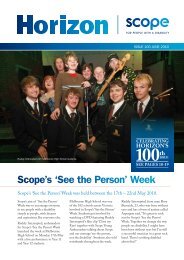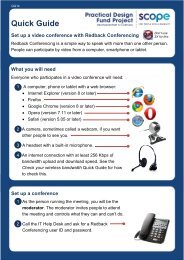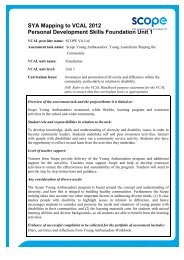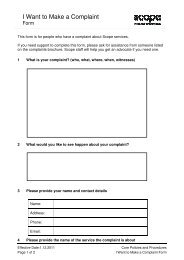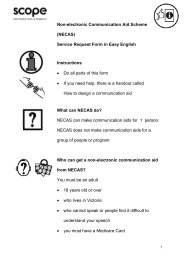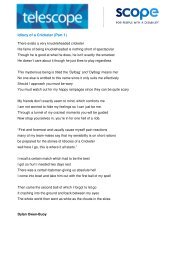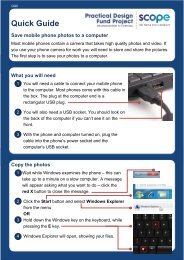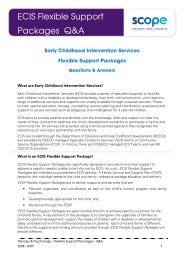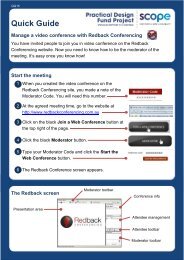Positive behaviour support Getting it right from the start
Positive behaviour support Getting it right from the start
Positive behaviour support Getting it right from the start
You also want an ePaper? Increase the reach of your titles
YUMPU automatically turns print PDFs into web optimized ePapers that Google loves.
52 <strong>Pos<strong>it</strong>ive</strong> <strong>behaviour</strong> <strong>support</strong>: <strong>Getting</strong> <strong>it</strong> <strong>right</strong> <strong>from</strong> <strong>the</strong> <strong>start</strong> - Facil<strong>it</strong>ators reference manual<br />
Using AAC appropriately w<strong>it</strong>h intentional and unintentional communicators<br />
Skills of <strong>the</strong><br />
person at this<br />
level<br />
What symbols to<br />
use?<br />
Visual cues/<br />
symbols to use<br />
w<strong>it</strong>h <strong>the</strong> person<br />
General<br />
strategies used<br />
by effective<br />
communication<br />
partners<br />
Unintentional<br />
passive (UP)<br />
Unintentional<br />
active (UA)<br />
UP – All interactions are based on <strong>the</strong><br />
communication partner’s awareness of<br />
<strong>the</strong> person’s needs and observations of<br />
<strong>the</strong> person’s <strong>behaviour</strong>.<br />
UA – The person is much more likely<br />
to reach out for things that attract <strong>the</strong>ir<br />
attention and interest. All interactions are<br />
based on <strong>the</strong> communication partner’s<br />
awareness of <strong>the</strong> person’s needs and<br />
observations of <strong>the</strong>ir <strong>behaviour</strong>.<br />
Non-symbolic<br />
Intentional<br />
informal (II)<br />
The person<br />
knows that o<strong>the</strong>r<br />
people can be<br />
useful. The person<br />
understands that<br />
for communication<br />
to occur, <strong>the</strong><br />
attention of a<br />
communication<br />
partner is required.<br />
The way person<br />
communicates may<br />
be hard for o<strong>the</strong>rs<br />
to understand.<br />
Person cannot understand spoken language alone, photos and<br />
line drawing (e.g. COMPIC, Boardmaker PCS)<br />
Real objects: <strong>the</strong><br />
actual object must<br />
be used when<br />
communicating<br />
w<strong>it</strong>h <strong>the</strong> person<br />
or making up<br />
communication<br />
boards or books.<br />
Real objects: <strong>the</strong><br />
actual object must<br />
be used when<br />
communicating<br />
w<strong>it</strong>h <strong>the</strong> person<br />
or making up<br />
communication<br />
boards or books.<br />
Real objects: <strong>the</strong><br />
actual object must<br />
be used when<br />
communicating<br />
w<strong>it</strong>h <strong>the</strong> person<br />
or making up<br />
communication<br />
boards or books.<br />
Intentional<br />
symbolic basic<br />
(SB)<br />
A person is able<br />
to communicate<br />
symbolically.<br />
The person<br />
communicates a<br />
range of intentions<br />
or functions<br />
through pictures,<br />
gestures, single<br />
words and/or<br />
vocalizations.<br />
Symbolic<br />
Intentional symbolic<br />
established (SE)<br />
The person is communicating<br />
at an established symbolic<br />
level. He or she can recognise<br />
a large number of pictures,<br />
photos and line drawings<br />
and is more likely to use<br />
<strong>the</strong>se to in<strong>it</strong>iate interactions<br />
w<strong>it</strong>h familiar people. Photos,<br />
pictures and line drawings<br />
may also be incorporated<br />
into a range of different<br />
communication aids including<br />
electronic communication<br />
devices, boards, books and<br />
wallets.<br />
The person may put signs,<br />
pictures or words toge<strong>the</strong>r<br />
to make simple two-word<br />
phrases. The person may use<br />
<strong>the</strong>ir communication skills to<br />
comment, chat, request or<br />
reject something.<br />
They also have a reliable way<br />
of indicating yes and no simple<br />
questions. If something is<br />
missing, <strong>the</strong>y may seek help<br />
<strong>from</strong> o<strong>the</strong>rs or try to remember<br />
where <strong>the</strong>y last saw <strong>it</strong>.<br />
Person can understand simple 1-2 step instructions<br />
and can use photos and line drawing (e.g. COMPIC,<br />
Boardmaker PCS for communication)<br />
Photographs<br />
Line drawings<br />
(COMPIC or P.C.S)<br />
must be used when<br />
communicating<br />
w<strong>it</strong>h <strong>the</strong> person<br />
or making up<br />
communication<br />
boards or books.<br />
Line drawings (Boardmaker,<br />
COMPIC and possibly<br />
familiar word) must be used<br />
when communicating w<strong>it</strong>h<br />
<strong>the</strong> person or making up<br />
communication boards or<br />
books.<br />
Refer to page 33 of this reference manual for general strategies used by effective communication partners.<br />
Key word signing 16 to be used by all communication partners regardless of <strong>the</strong> person’s level of communication.<br />
Consistent use of key word sign by communication partners will assist <strong>the</strong> person to understand what is happening or<br />
what is expected of <strong>the</strong>m. W<strong>it</strong>h consistent use some people may learn to use key word signing to express <strong>the</strong>mselves.<br />
16. A manual signing approach that combines speaking and signing and produced in English word order (Grove and Walker 1990).



